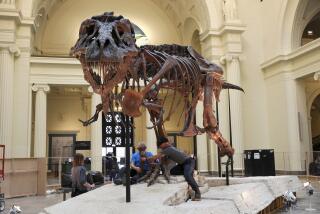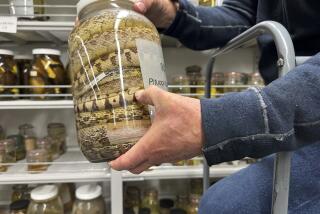Towering T. Rex to Go on Display
CHICAGO — By any measure, Sue is big.
Standing 13 feet tall at the hips and stretching 41 feet long with teeth as long as your forearm, Sue is the largest, most complete and best-preserved Tyrannosaurus rex skeleton ever discovered.
With Hollywood-style razzle-dazzle, the reassembled skeleton goes on display today for the first time.
In advance of the opening at Chicago’s Field Museum, dinosaur logos are plastered on T-shirts and city buses, and the final look of the exhibit is shrouded in secrecy.
Sue, named after Sue Hendrickson, the fossil hunter who found her in 1990 in the badlands of South Dakota, cost the natural history museum $8.36 million at an auction that had been delayed for years by a drawn-out legal battle that ended with Hendrickson’s partner in jail.
To cover the cost of the 65-million-year-old carnivore, the Field took on two mega-corporate partners, McDonald’s and Disney. Both get exclusive rights to casts of Sue’s bones.
But only the Field Museum’s visitors get to see the bones. The museum will display her (scientists cannot say for sure whether Sue was male or female) in the main hall.
Her 1-ton skull, too heavy to be mounted with the rest of the skeleton, will be displayed in a case nearby. A lightweight cast will replace it on the skeleton.
“People, in all the alternatives they have in computer games, shopping, the Internet . . . love real things,” Field President John McCarter said.
The Sue exhibit is an example of an emerging blockbuster mentality among museums that are trying to compete with movies, theme parks and sports for family free time. Big projects mean big money, which often means corporate sponsors.
“Museums about 20 years ago began to make themselves intellectually accessible to the public,” said Edward Able Jr., president of the American Assn. of Museums. They moved away from static, dusty displays toward more entertaining, easier-to-understand fare, he said.
The more entertaining approach, along with the robust economy and an increase in popular interest in science, has contributed to a 50% increase in U.S. museum attendance over the last 10 years, Able said.
Creators of the exhibit sought to make it fun and informative.
“We have a couple of people here on staff who come to me and say, ‘This is not the museum of my childhood,’ ” McCarter said. “And it’s not!”
The exhibit explain facts and theories about Sue and explodes some Hollywood myths.
For example, it explains that an examination of Sue’s skull with an industrial CT scanner yielded the theory that the T. rex’s olfactory bulbs, which control the sense of smell, were each bigger than the cerebrum, the thinking part of the brain.
“Remember the scene in ‘Jurassic Park’ with the T. rex?” asked the exhibit’s assistant developer, Becky Margolin. “When Sam Neill was telling the kids if you don’t move, it can’t see you? The thing we can now theorize is that he definitely would have smelled them and would have eaten them anyway.”
More findings by Field researchers will be introduced in the exhibit as they emerge.
“It enables us to use the dinosaur as an introduction to the study of paleontology,” McCarter said. “It’s a wonderful way to share science.”
More to Read
The biggest entertainment stories
Get our big stories about Hollywood, film, television, music, arts, culture and more right in your inbox as soon as they publish.
You may occasionally receive promotional content from the Los Angeles Times.










